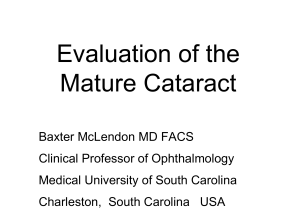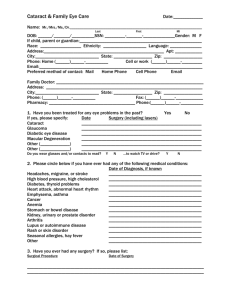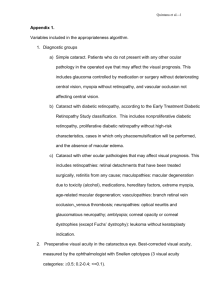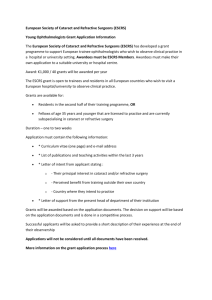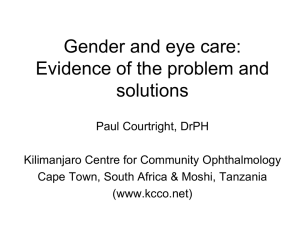Protocol Project Title: A retrospective analysis of the association
advertisement
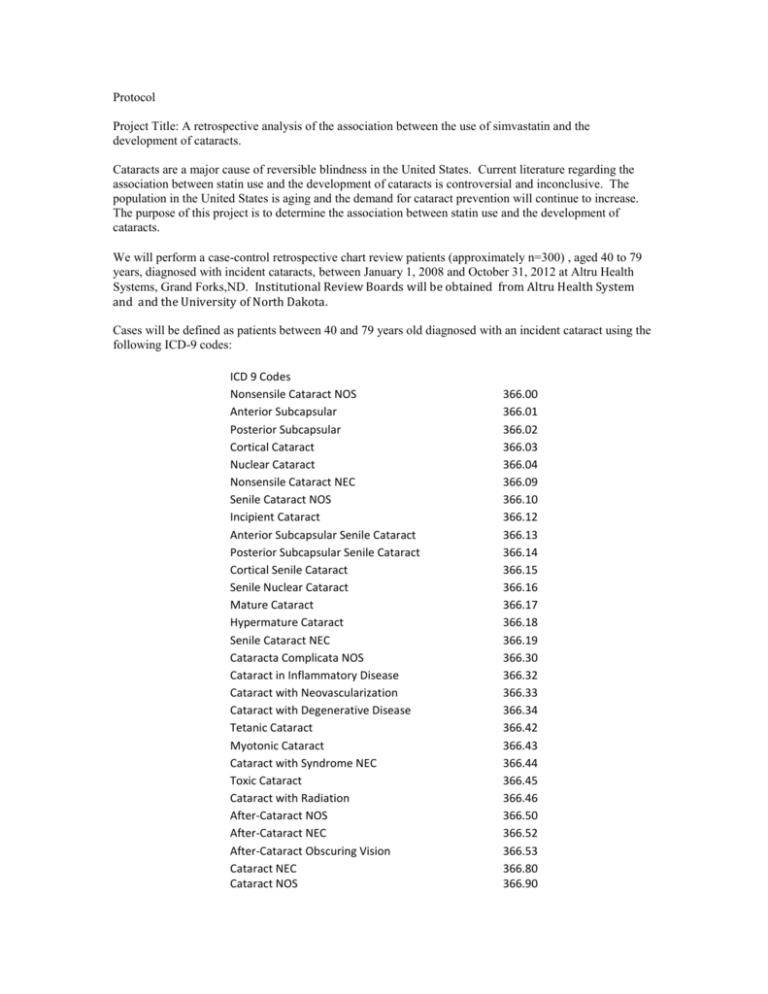
Protocol Project Title: A retrospective analysis of the association between the use of simvastatin and the development of cataracts. Cataracts are a major cause of reversible blindness in the United States. Current literature regarding the association between statin use and the development of cataracts is controversial and inconclusive. The population in the United States is aging and the demand for cataract prevention will continue to increase. The purpose of this project is to determine the association between statin use and the development of cataracts. We will perform a case-control retrospective chart review patients (approximately n=300) , aged 40 to 79 years, diagnosed with incident cataracts, between January 1, 2008 and October 31, 2012 at Altru Health Systems, Grand Forks,ND. Institutional Review Boards will be obtained from Altru Health System and and the University of North Dakota. Cases will be defined as patients between 40 and 79 years old diagnosed with an incident cataract using the following ICD-9 codes: ICD 9 Codes Nonsensile Cataract NOS Anterior Subcapsular Posterior Subcapsular Cortical Cataract Nuclear Cataract Nonsensile Cataract NEC Senile Cataract NOS Incipient Cataract Anterior Subcapsular Senile Cataract Posterior Subcapsular Senile Cataract Cortical Senile Cataract Senile Nuclear Cataract Mature Cataract Hypermature Cataract Senile Cataract NEC Cataracta Complicata NOS Cataract in Inflammatory Disease Cataract with Neovascularization Cataract with Degenerative Disease Tetanic Cataract Myotonic Cataract Cataract with Syndrome NEC Toxic Cataract Cataract with Radiation After-Cataract NOS After-Cataract NEC After-Cataract Obscuring Vision Cataract NEC Cataract NOS 366.00 366.01 366.02 366.03 366.04 366.09 366.10 366.12 366.13 366.14 366.15 366.16 366.17 366.18 366.19 366.30 366.32 366.33 366.34 366.42 366.43 366.44 366.45 366.46 366.50 366.52 366.53 366.80 366.90 Congenital Cataract NOS Capsular Cataract Cortical/Zonular Cataract Nuclear Cataract Congenital Total/Subtotal Cataract Congenital Cataract/Lens Anomaly NEC Cataract Extraction Status 743.30 743.31 743.32 743.33 743.34 743.39 v45.61 Excluded from the study will be any patient with the following diagnoses and/or medications in their medical history after the index date (incident cataract) and/or 3 years prior:: Diabetes Mellitus, Diabetic Cataract 366.41, Myotonic Dystrophy, Atopic Dermatitis, Neurofibromatosis Type 2, Galactosemia, Homocystinemia, Wilson’s Disease, Down’s Syndrome, Chronic Anterior Uveitis, Acute Angle Closure Glaucoma, Steroid Use (Systemic, Topical), High Myopia, Hereditary fundus dystrophies (Retinitis Pigmentosa, Leber, Gyrate, Atrophy, Erickler), Radiation, UVA/UVB light, Medications (psoralens, antipsychotics [chlorpromatine], allopurinol, tamoxifen, amiodarone, tricyclic antidepressants, K-sparing diuretics, thyroid hormone, tetracycline, suflamylonmephentine), trauma, congenital, s/p vitrectomy, s/p glaucoma treatment. Also excluded will be anyone with the following diagnosis/ICD-9 prior to the index date: cataract -366. x; corneal opacity and other disorders of cornea-371.x; Glaucoma – 365.x; Disorders of iris and ciliary body - 364.x; Retinal detachments and defects – 361.x; Inflammation of eyelids – 373.x. Controls will be randomly selected from patients (approx.. n=300) aged 40-79 years being seen for a general physical exam (ICD-9: V70). Controls will be matched by gender and age (±2 years), as well as calendar year of index year (cataract occurrence) of cases. Data to be recorded will include: Age, gender, race, smoking history, coronary artery disease, metabolic syndrome, statin use, statin type, lipid-lowering use, lipid-lowering type, steroid use, steroid type, HbA1c, hypertension, type of cataract, lipid profile, comorbidities. The software application SPSS 19.0 for Windows will used to analyze demographic and clinical characteristics of patients. Frequencies and relative percentages will be computed for each categorical variable. Chi-square tests or Fisher’s exact tests will be performed to determine which categories were significantly different from one another, and t-test will be used to compare continuous variables. All p-values will be two-sided, and p-value < 0.05 will be considered significant. Missing data will be excluded from analysis. Society would benefit from knowing whether or not the ubiquitous statin medications are associated with an increased risk of developing cataracts in order to better manage healthcare. For the purpose of this study, there will be no physical interaction between the principal investigators and the patients whose charts are being reviewed. Furthermore, no procedures will be performed nor will direct interaction occur with patients of this study. Data will be stored securely on password-protected computers and files. The data file will not contain any identifying information such as patients’ names or medical record numbers. Only those involved in the research project will be able to access the data. Data will be stored in the Department of Family and Community Medicine at the UND School of Medicine and Health Sciences for a period of six years after analysis.



